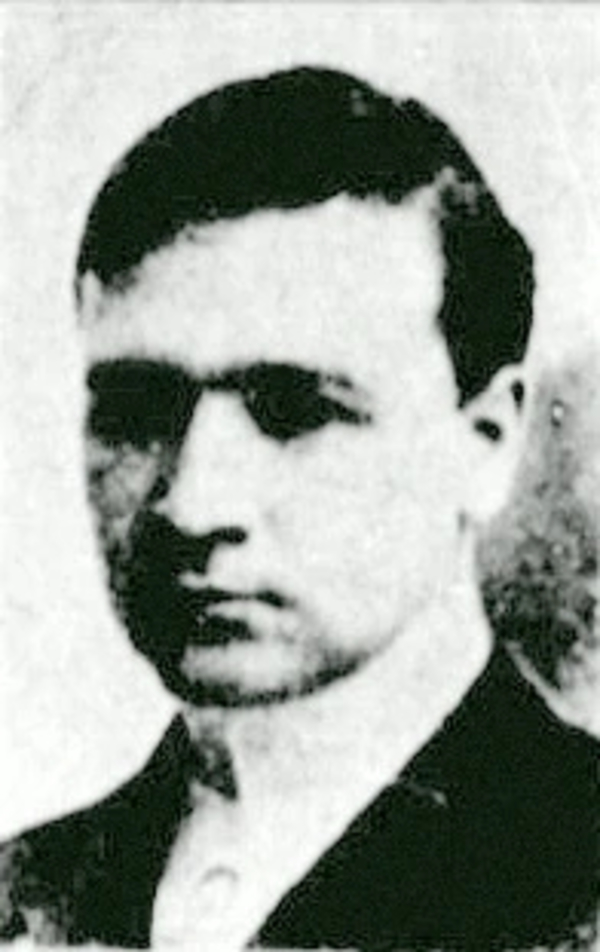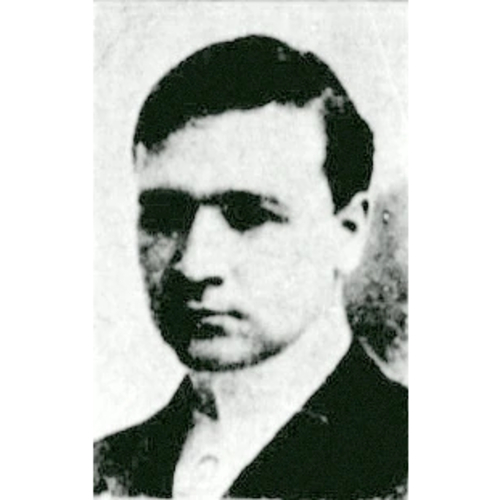
Source: Link
CHARLEBOIS, JOSEPH (baptized Joseph-Charles-Théophile) (he used the pseudonyms Mathias, Josepho, Sorel, Basibi, and Jos Kerr), civil servant, artist, newspaper proprietor, author, and teacher; b. 5 March 1872 in the parish of Notre-Dame, Montreal, son of Charles-Théophile Charlebois and Marie-Olive-Caroline Lauzon; m. 4 Oct. 1898 Blanche Herard (d. 5 Nov. 1924) in the parish of Saint-Jacques-le-Majeur in the same city, and they had four children; m. secondly 23 April 1925 Bernardina Thor in Jersey City, N.J.; d. 20 Oct. 1935 in Montreal and was buried there three days later in Notre-Dame-des-Neiges cemetery.
The grandfather of Joseph Charlebois was a native of Saint-Joseph-de-Soulanges (Les Cèdres), Que. Joseph’s father was born in Saint-Polycarpe in 1846. Charles-Théophile settled in Montreal in 1871, where he remained until his death in 1930. He established a business as a decorative and sign painter, upholsterer, and glazier, attracting the attention of the press, which noted the quality of his frescoes and interior decoration, especially when he carried out work at Montreal’s city hall in 1893.
Joseph studied at the Catholic Commercial Academy of Montreal, which was run by Urgel-Eugène Archambeault*. The school offered drawing classes from year one. It is thought that between about 1879 and 1887 Charlebois learned pencil and charcoal drawing there with the Swiss-born artist Joseph‑F. Brouchoud and the Italian-born decorative painter Luigi Giovanni Vitale Capello*. In 1890 he joined the roads department of the city of Montreal as a clerk. He was promoted to draughtsman three years later and subsequently rose through the ranks to become assistant designer in 1898 and then head designer, a position he held from 1907 to 1910. As a civil servant he produced technical drawings, plans, and maps, as well as illuminated documents presented by city hall as tokens of goodwill and respect to important guests, among them King Edward VII in 1902, Cardinal Désiré-Joseph Mercier of Belgium in 1910, and King George V in 1911. At the 1900 universal exposition in Paris Charlebois had displayed an illuminated work produced for the Supreme Court of the Independent Order of Foresters, a mutual-benefit society. In 1903 he exhibited caricatures and ornamented pieces at the First Annual Loan and Sale Exhibition of the Newspaper Artists’ Association in Montreal. The artist’s son, Roland-Hérard Charlebois, would also become a distinguished illuminator.
Along with his work as a municipal civil servant, Charlebois pursued a career as a caricaturist and cartoonist in the city. From December 1899 to December 1902 he contributed to the weekly Liberal newspaper Les Débats. In 1903 he launched his first album, Nos p’tites filles: en caricature, in the introductory issue of his humorous newspaper Le Taon, which would eventually continue publication from 1907 to 1910. Twelve more albums of caricature would appear, four of them unattributed. In these publications Charlebois used social and political satire to scrutinize certain aspects of contemporary life. His favourite political target was the premier of the province of Quebec, Sir Lomer Gouin*. Nor did he spare the prime minister of Canada, Sir Wilfrid Laurier*, the politician and editor of Le Devoir, Henri Bourassa*, or the mayor of Montreal, Médéric Martin*. Like the journalists Olivar Asselin and Jules Fournier*, whose nationalist views he shared, he was sensitive to the status of francophone minorities in North America. In La Bêche (The spade) ou les assimilateurs en action, he denounced the assimilation tactics of New England’s Roman Catholic Irish clergy, which he saw as a threat to the survival of the parishes and schools of Franco-American minorities. Such remarks did not please the Catholic press, which could not, however, oppose them too openly for fear of alienating French Canadian opinion. The war, conscription, Prohibition, and immigration were his other chosen topics, and he even ventured into the minefield of relations between various ethnic and religious communities. In 1913, for example, he published Montréal juif: dessins gais, an album of caricatures that pandered to the most shopworn of anti-Semitic prejudices, such as the one associating the rise of Jewish immigration in the province with a danger to the continued presence of French Canadians and a takeover of the economic and political affairs of the country.
In Montreal, following his journalistic debut with Les Débats in 1899, Charlebois contributed between 1904 and 1919 to two nationalist weeklies, Le Nationaliste and L’Action, most often by producing caricatures but also articles. In addition, his work appeared in Les Vrais Débats, L’Avenir, La Patrie, and cultural periodicals such as L’Indiscret and Le Passe-Temps. In 1909 he also signed a few drawings in the humour magazine La Bombe. In his caricatures he placed his subjects in comic situations. He added text to the image, readily putting words from popular speech into the mouths of his characters. He also created caricatures for “Nos artistes,” a series published in Le Taon and Le Nationaliste and elsewhere. The preferred tools of this prolific artist were pen and India ink. Occasionally, he would dash off a rough sketch, but his compositions typically showed a genuine concern for aesthetics. His drawings, colder and more static than those of the artist and caricaturist Henri Julien*, skilfully combined contour lines, hatching, and solid forms to create realistic scenes to which the captions added a comic or satirical touch.
Charlebois made a brief foray into comic strips. From March 1904 to February 1905 he drew the adventures of Père Ladébauche for the Saturday edition of La Presse. Broadly inspired by the character invented in 1878 by Hector Berthelot*, his Baptiste Ladébauche was a French Canadian who dreamed of moving up in society. The theme of aspiring to middle-class respectability vied in his work with such human and social weaknesses as greed, vanity, corruption, ignorance, and stupidity.
From 1920 to 1928 Joseph Charlebois worked in New York City as an illuminator and head of studio for the company Ames and Rollinson. He travelled in France in 1928 during a sabbatical year and returned to Montreal in February 1929, where he taught lettering at the Arts and Trades School. Between 1931 and 1935 he exhibited drawings and illuminated works at the Art Association of Montreal. The latter earned him rave reviews from the writer Albert Laberge*, who in his work Peintres et écrivains d’hier et d’aujourd’hui provided a vivid portrait of the artist. Charlebois, who had become a friend after they met in 1902, was then a model of elegance, “a Beau Brummel” who made heads turn wherever he went. In the drawings of this moralizing caricaturist, Laberge noted “the depiction of social mores that he has executed [in a] biting, spirited[,] and faithful [manner].” Later, upon discovering Charlebois’s illuminated works, Laberge detected quite a different person: a man of great culture, who mastered to perfection an ancient art of immense refinement and subtlety – quite the opposite, in fact, of the caricaturist for whom it was essential to exaggerate his strokes to hit the mark.
The name Joseph Charlebois appears on the following albums of cartoons: The Prince of Wales at the tercentenary celebration of the founding of Quebec: album of cartoons (Montreal?, 1908?), which appeared simultaneously in French; La bêche (The spade) ou les assimilateurs en action, dédié aux Franco-Américains de la Nouvelle-Angleterre: album de dessins gais (Montréal, [1911?]); Saint-Jean-Baptiste d’autrefois ([Montréal, 1912?]); Monsieur Gouin voyage: dessins gais (Montréal, 1913); Montréal juif: dessins gais (Montréal, 1913); Boches (Montréal, 1915); La conscription: tristes dessins et légendes tristes (Montréal, 1917); and La prohibition: album de caricatures ([Montréal?, 1919?]). He is credited with the following anonymous albums: J. A. Beaudry, assistant-aspirant-contrôleur de la cité de Montréal (n.p., n.d.); Duncan MacDonald, ou le gentleman-cambrioleur de l’opinion publique (n.p., [between 1910 and 1919]); Figures et masques: quelques marionnettes électorales (n.p., [between 1914 and 1928]); and Guerlot Cousineau alias Philomène, aspirant-chef du gouvernement de Québec ([Montréal?], 1916).
Some of his drawings appeared in the novel Rédemption (Montréal, 1906), written by Rodolphe Girard and illustrated by Georges Delfosse, and in Nos amis les Québecquois: album de caricatures (Montréal, [1913?]) by Charles Huard.
As a draftsman for the city of Montreal, Charlebois charted the Official plan of the city of Montreal and its municipal divisions in 1904 (n.p., [1904?]) and the Plan de la cité de Montréal: ses principaux monuments religieux et civils, voies de communication (n.p., 1910).
Illustrations and drawings by Charlebois are held at LAC (Fonds Joseph Charlebois; Fonds Joseph Charlebois collection; R2473-1-8), BANQ-CAM (MSS124; P461), and the Musée National des Beaux-Arts du Québec (Québec).
BANQ-CAM, CE601-S33, 4 oct. 1898; CE601-S41, 5 févr. 1811; CE601-S51, 6 mars 1872, 8 nov. 1924, 8 juill. 1930; CE601-S55, 5 sept. 1831, 11 oct. 1846. BANQ-Q, E6, S7, SS1, P28664, P61598, P61599; E57, S44, SS1, PC2-55; P597. FD, Notre-Dame (Montréal), 8 nov. 1924, 8 juill. 1930; Saint-Jacques, cathédrale de Montréal [Saint-Jacques-le-Majeur], 3 oct. 1931, 23 oct. 1935. L’Avenir (Montréal), 28 oct. 1900. Les Débats (Montréal), 10, 24 déc. 1899; 21 janv., 4 nov. 1900. Le Devoir, 21 oct. 1935. La Minerve (Montréal), 3 déc. 1877, 1er déc. 1880, 18 avril 1893. Le Nationaliste (Montréal), 6, 20, 24 mars, 24 avril 1904. Le Petit Journal (Montréal), 1er mars 1964. Le Taon (Montréal), juillet 1907–février 1910. Les Vrais Débats ([Montréal]), 14 oct. 1900. Art Assoc. of Montreal, The catalogue of first annual loan and sale exhibition of the Newspaper Artists’ Association … ([Montreal?, 1903?]), 21. Peter Desbarats and Terry Mosher, The hecklers: a history of Canadian political cartooning and a cartoonists’ history of Canada (Toronto, 1979). Mira Falardeau, Histoire de la bande dessinée au Québec (Montréal, 2008). Aristide Filiatreault, Mes étrennes: la hache versus la bêche ([Montréal?, 1912?]). J. Hamelin et al., La presse québécoise, 2–5. J. R. Harper, Early painters and engravers in Canada (Toronto, 1970). Karel, Dict. des artistes. Albert Laberge, Peintres et écrivains d’hier et d’aujourd’hui (Montréal, 1938). Alfred Laliberté, Les artistes de mon temps, Odette Legendre, édit. (Montréal, 1986). A[drien] Leblond de Brumath, Le livre d’or de l’académie commerciale catholique de Montréal … ([Montréal?], 1906). Laurent Mailhot et D.‑M. Montpetit, Monologues québécois, 1890–1980 ([Montréal], 1980). Montreal Museum of Fine Arts, formerly Art Association of Montreal: spring exhibitions, 1880–1970, comp. E. de R. McMann (Toronto, 1988). Montreal, Treasurer’s Office, Annual report …, 1889–96, 1897, 1898–1901, 1902–3, 1904–11. Sara Richard, “La production satirique illustrée du caricaturiste montréalais Joseph Charlebois (1872–1935)” (mémoire de ma, univ. de Sherbrooke, Québec, 2006). Royal Canadian Academy of Arts: exhibitions and members, 1880–1979, comp. E. de R. McMann (Toronto, 1981). Universal Exposition, Official catalogue of the works of art exhibited in the Canadian pavillion (Paris, 1900).
Revisions based on:
N.J., State Dept., N.J. State Arch. (Trenton), Marriage records, vol. 7, p.48 (23 April 1925).
Cite This Article
Hélène Sicotte, “CHARLEBOIS, JOSEPH (baptized Joseph-Charles-Théophile) (Mathias, Josepho, Sorel, Basibi, Jos Kerr),” in Dictionary of Canadian Biography, vol. 16, University of Toronto/Université Laval, 2003–, accessed December 21, 2025, https://www.biographi.ca/en/bio/charlebois_joseph_16E.html.
The citation above shows the format for footnotes and endnotes according to the Chicago manual of style (16th edition). Information to be used in other citation formats:
| Permalink: | https://www.biographi.ca/en/bio/charlebois_joseph_16E.html |
| Author of Article: | Hélène Sicotte |
| Title of Article: | CHARLEBOIS, JOSEPH (baptized Joseph-Charles-Théophile) (Mathias, Josepho, Sorel, Basibi, Jos Kerr) |
| Publication Name: | Dictionary of Canadian Biography, vol. 16 |
| Publisher: | University of Toronto/Université Laval |
| Year of publication: | 2020 |
| Year of revision: | 2021 |
| Access Date: | December 21, 2025 |



